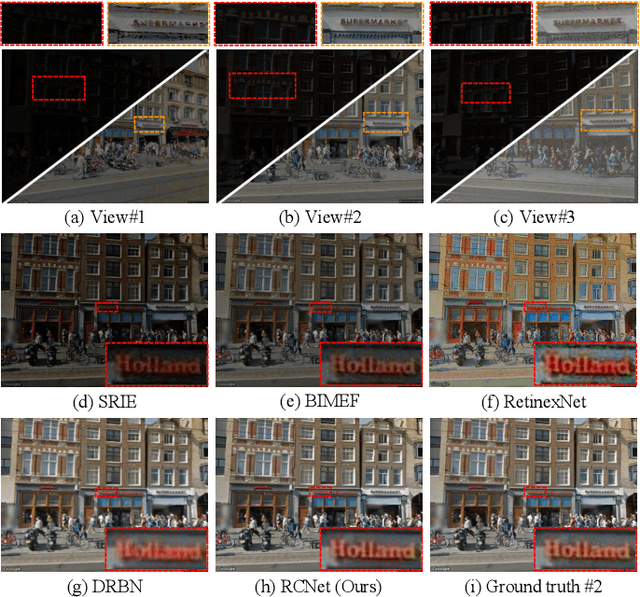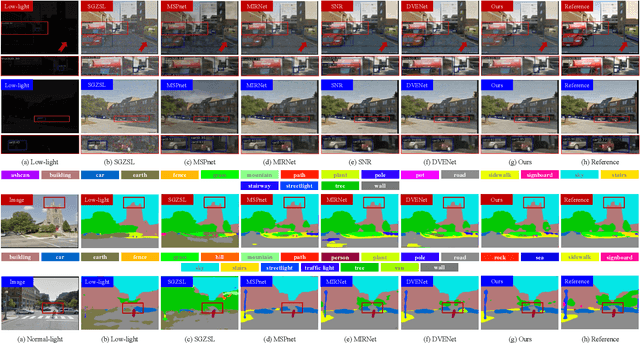Peilin Chen
Leveraging Diffusion Knowledge for Generative Image Compression with Fractal Frequency-Aware Band Learning
Mar 14, 2025Abstract:By optimizing the rate-distortion-realism trade-off, generative image compression approaches produce detailed, realistic images instead of the only sharp-looking reconstructions produced by rate-distortion-optimized models. In this paper, we propose a novel deep learning-based generative image compression method injected with diffusion knowledge, obtaining the capacity to recover more realistic textures in practical scenarios. Efforts are made from three perspectives to navigate the rate-distortion-realism trade-off in the generative image compression task. First, recognizing the strong connection between image texture and frequency-domain characteristics, we design a Fractal Frequency-Aware Band Image Compression (FFAB-IC) network to effectively capture the directional frequency components inherent in natural images. This network integrates commonly used fractal band feature operations within a neural non-linear mapping design, enhancing its ability to retain essential given information and filter out unnecessary details. Then, to improve the visual quality of image reconstruction under limited bandwidth, we integrate diffusion knowledge into the encoder and implement diffusion iterations into the decoder process, thus effectively recovering lost texture details. Finally, to fully leverage the spatial and frequency intensity information, we incorporate frequency- and content-aware regularization terms to regularize the training of the generative image compression network. Extensive experiments in quantitative and qualitative evaluations demonstrate the superiority of the proposed method, advancing the boundaries of achievable distortion-realism pairs, i.e., our method achieves better distortions at high realism and better realism at low distortion than ever before.
Data Foundations for Large Scale Multimodal Clinical Foundation Models
Mar 09, 2025Abstract:Recent advances in clinical AI have enabled remarkable progress across many clinical domains. However, existing benchmarks and models are primarily limited to a small set of modalities and tasks, which hinders the development of large-scale multimodal methods that can make holistic assessments of patient health and well-being. To bridge this gap, we introduce Clinical Large-Scale Integrative Multimodal Benchmark (CLIMB), a comprehensive clinical benchmark unifying diverse clinical data across imaging, language, temporal, and graph modalities. CLIMB comprises 4.51 million patient samples totaling 19.01 terabytes distributed across 2D imaging, 3D video, time series, graphs, and multimodal data. Through extensive empirical evaluation, we demonstrate that multitask pretraining significantly improves performance on understudied domains, achieving up to 29% improvement in ultrasound and 23% in ECG analysis over single-task learning. Pretraining on CLIMB also effectively improves models' generalization capability to new tasks, and strong unimodal encoder performance translates well to multimodal performance when paired with task-appropriate fusion strategies. Our findings provide a foundation for new architecture designs and pretraining strategies to advance clinical AI research. Code is released at https://github.com/DDVD233/climb.
An Information-Theoretic Regularizer for Lossy Neural Image Compression
Nov 23, 2024Abstract:Lossy image compression networks aim to minimize the latent entropy of images while adhering to specific distortion constraints. However, optimizing the neural network can be challenging due to its nature of learning quantized latent representations. In this paper, our key finding is that minimizing the latent entropy is, to some extent, equivalent to maximizing the conditional source entropy, an insight that is deeply rooted in information-theoretic equalities. Building on this insight, we propose a novel structural regularization method for the neural image compression task by incorporating the negative conditional source entropy into the training objective, such that both the optimization efficacy and the model's generalization ability can be promoted. The proposed information-theoretic regularizer is interpretable, plug-and-play, and imposes no inference overheads. Extensive experiments demonstrate its superiority in regularizing the models and further squeezing bits from the latent representation across various compression structures and unseen domains.
Compact Visual Data Representation for Green Multimedia -- A Human Visual System Perspective
Nov 21, 2024Abstract:The Human Visual System (HVS), with its intricate sophistication, is capable of achieving ultra-compact information compression for visual signals. This remarkable ability is coupled with high generalization capability and energy efficiency. By contrast, the state-of-the-art Versatile Video Coding (VVC) standard achieves a compression ratio of around 1,000 times for raw visual data. This notable disparity motivates the research community to draw inspiration to effectively handle the immense volume of visual data in a green way. Therefore, this paper provides a survey of how visual data can be efficiently represented for green multimedia, in particular when the ultimate task is knowledge extraction instead of visual signal reconstruction. We introduce recent research efforts that promote green, sustainable, and efficient multimedia in this field. Moreover, we discuss how the deep understanding of the HVS can benefit the research community, and envision the development of future green multimedia technologies.
RCNet: Deep Recurrent Collaborative Network for Multi-View Low-Light Image Enhancement
Sep 06, 2024



Abstract:Scene observation from multiple perspectives would bring a more comprehensive visual experience. However, in the context of acquiring multiple views in the dark, the highly correlated views are seriously alienated, making it challenging to improve scene understanding with auxiliary views. Recent single image-based enhancement methods may not be able to provide consistently desirable restoration performance for all views due to the ignorance of potential feature correspondence among different views. To alleviate this issue, we make the first attempt to investigate multi-view low-light image enhancement. First, we construct a new dataset called Multi-View Low-light Triplets (MVLT), including 1,860 pairs of triple images with large illumination ranges and wide noise distribution. Each triplet is equipped with three different viewpoints towards the same scene. Second, we propose a deep multi-view enhancement framework based on the Recurrent Collaborative Network (RCNet). Specifically, in order to benefit from similar texture correspondence across different views, we design the recurrent feature enhancement, alignment and fusion (ReEAF) module, in which intra-view feature enhancement (Intra-view EN) followed by inter-view feature alignment and fusion (Inter-view AF) is performed to model the intra-view and inter-view feature propagation sequentially via multi-view collaboration. In addition, two different modules from enhancement to alignment (E2A) and from alignment to enhancement (A2E) are developed to enable the interactions between Intra-view EN and Inter-view AF, which explicitly utilize attentive feature weighting and sampling for enhancement and alignment, respectively. Experimental results demonstrate that our RCNet significantly outperforms other state-of-the-art methods. All of our dataset, code, and model will be available at https://github.com/hluo29/RCNet.
Generative Visual Compression: A Review
Feb 03, 2024Abstract:Artificial Intelligence Generated Content (AIGC) is leading a new technical revolution for the acquisition of digital content and impelling the progress of visual compression towards competitive performance gains and diverse functionalities over traditional codecs. This paper provides a thorough review on the recent advances of generative visual compression, illustrating great potentials and promising applications in ultra-low bitrate communication, user-specified reconstruction/filtering, and intelligent machine analysis. In particular, we review the visual data compression methodologies with deep generative models, and summarize how compact representation and high-fidelity reconstruction could be actualized via generative techniques. In addition, we generalize related generative compression technologies for machine vision and intelligent analytics. Finally, we discuss the fundamental challenges on generative visual compression techniques and envision their future research directions.
2AFC Prompting of Large Multimodal Models for Image Quality Assessment
Feb 02, 2024



Abstract:While abundant research has been conducted on improving high-level visual understanding and reasoning capabilities of large multimodal models~(LMMs), their visual quality assessment~(IQA) ability has been relatively under-explored. Here we take initial steps towards this goal by employing the two-alternative forced choice~(2AFC) prompting, as 2AFC is widely regarded as the most reliable way of collecting human opinions of visual quality. Subsequently, the global quality score of each image estimated by a particular LMM can be efficiently aggregated using the maximum a posterior estimation. Meanwhile, we introduce three evaluation criteria: consistency, accuracy, and correlation, to provide comprehensive quantifications and deeper insights into the IQA capability of five LMMs. Extensive experiments show that existing LMMs exhibit remarkable IQA ability on coarse-grained quality comparison, but there is room for improvement on fine-grained quality discrimination. The proposed dataset sheds light on the future development of IQA models based on LMMs. The codes will be made publicly available at https://github.com/h4nwei/2AFC-LMMs.
Deep Shape-Texture Statistics for Completely Blind Image Quality Evaluation
Jan 16, 2024



Abstract:Opinion-Unaware Blind Image Quality Assessment (OU-BIQA) models aim to predict image quality without training on reference images and subjective quality scores. Thereinto, image statistical comparison is a classic paradigm, while the performance is limited by the representation ability of visual descriptors. Deep features as visual descriptors have advanced IQA in recent research, but they are discovered to be highly texture-biased and lack of shape-bias. On this basis, we find out that image shape and texture cues respond differently towards distortions, and the absence of either one results in an incomplete image representation. Therefore, to formulate a well-round statistical description for images, we utilize the shapebiased and texture-biased deep features produced by Deep Neural Networks (DNNs) simultaneously. More specifically, we design a Shape-Texture Adaptive Fusion (STAF) module to merge shape and texture information, based on which we formulate qualityrelevant image statistics. The perceptual quality is quantified by the variant Mahalanobis Distance between the inner and outer Shape-Texture Statistics (DSTS), wherein the inner and outer statistics respectively describe the quality fingerprints of the distorted image and natural images. The proposed DSTS delicately utilizes shape-texture statistical relations between different data scales in the deep domain, and achieves state-of-the-art (SOTA) quality prediction performance on images with artificial and authentic distortions.
Geometric Prior Based Deep Human Point Cloud Geometry Compression
May 02, 2023Abstract:The emergence of digital avatars has raised an exponential increase in the demand for human point clouds with realistic and intricate details. The compression of such data becomes challenging with overwhelming data amounts comprising millions of points. Herein, we leverage the human geometric prior in geometry redundancy removal of point clouds, greatly promoting the compression performance. More specifically, the prior provides topological constraints as geometry initialization, allowing adaptive adjustments with a compact parameter set that could be represented with only a few bits. Therefore, we can envisage high-resolution human point clouds as a combination of geometric priors and structural deviations. The priors could first be derived with an aligned point cloud, and subsequently the difference of features is compressed into a compact latent code. The proposed framework can operate in a play-and-plug fashion with existing learning based point cloud compression methods. Extensive experimental results show that our approach significantly improves the compression performance without deteriorating the quality, demonstrating its promise in a variety of applications.
Cold-Start based Multi-Scenario Ranking Model for Click-Through Rate Prediction
Apr 16, 2023Abstract:Online travel platforms (OTPs), e.g., Ctrip.com or Fliggy.com, can effectively provide travel-related products or services to users. In this paper, we focus on the multi-scenario click-through rate (CTR) prediction, i.e., training a unified model to serve all scenarios. Existing multi-scenario based CTR methods struggle in the context of OTP setting due to the ignorance of the cold-start users who have very limited data. To fill this gap, we propose a novel method named Cold-Start based Multi-scenario Network (CSMN). Specifically, it consists of two basic components including: 1) User Interest Projection Network (UIPN), which firstly purifies users' behaviors by eliminating the scenario-irrelevant information in behaviors with respect to the visiting scenario, followed by obtaining users' scenario-specific interests by summarizing the purified behaviors with respect to the target item via an attention mechanism; and 2) User Representation Memory Network (URMN), which benefits cold-start users from users with rich behaviors through a memory read and write mechanism. CSMN seamlessly integrates both components in an end-to-end learning framework. Extensive experiments on real-world offline dataset and online A/B test demonstrate the superiority of CSMN over state-of-the-art methods.
 Add to Chrome
Add to Chrome Add to Firefox
Add to Firefox Add to Edge
Add to Edge